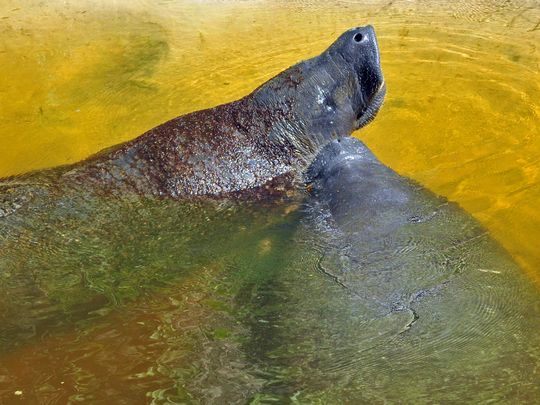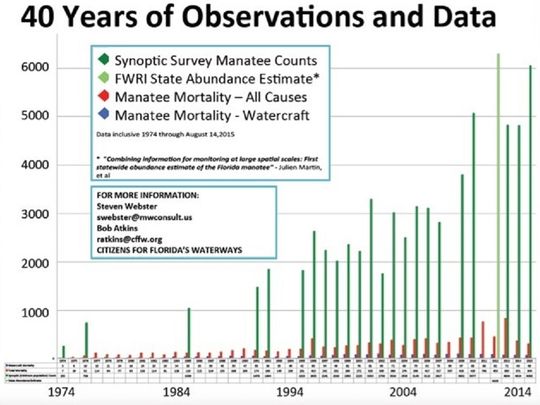Article Courtesy: floridatoday.com | By: Jim Waymer | Originally Published: December 30, 2015 | Please click here for original article.
The sea cow morphed into a sacred cow of sorts over the past half century. But Florida’s most iconic creature could soon flop down a peg from the lofty status it’s held since America’s original list of endangered species was created in 1967.
The U.S. Fish and Wildlife Service expects by fall 2016 to propose a rule to reclassify the Florida manatee from “endangered” to a less-serious status of “threatened.”
The move first would require a public input process and could face lengthy legal challenges.
The wildlife service assures the change wouldn’t dismantle slow-speed zones or lessen other protections for the species and only reflects the improvements to its numbers in recent years. But manatee advocates worry the reclassification would forge a slippery slope of deregulation that would eventually gut vital protections before serious threats to the species have been addressed.
The feds assert it won’t.
“Generally, the level of protection doesn’t change,” said Jeff Fleming, a spokesman with the U.S. Fish and Wildlife Service. “In some cases there are some opportunities to do some different things … with exemptions.”
The manatee’s listing status governs how state and federal agencies handle boating speed limits, dock and dredging permits and access to areas manatees frequent.
Word of the potential reclassification came via a Nov. 19 notice within an 181-page semiannual agenda of rules that federal agencies intend to review or develop between fall 2015 and fall 2016. The agenda lists the best guesses of what the wildlife service will do. But the reclassification to “threatened” is by no means a done deal, wildlife service officials said.
“We believe that a reduction in threats has resulted in an improvement in the species’ status such that the endangered designation may no longer correctly reflect the current status of manatee,” the notice states.
In July 2014, the wildlife service announced the agency would move forward on a status review for the manatee, in response to a 2012 petition to reclassify the species, from “endangered” to “threatened.”
Above: Manatees at Turkey Creek Sanctuary in Palm Bay. Photo: TIM SHORTT/FLORIDA TODAY
The wildlife service announced it would conduct the status review, just two months after a libertarian law foundation sued the agency over the matter. In May 2014, the The Pacific Legal Foundation sued the wildlife service for continuing to list the manatee as “endangered,” despite the agency’s own research that said the species should be reclassified as “threatened.”
The Pacific Legal Foundation is pursuing the lawsuit on behalf of Save Crystal River, Inc. That nonprofit citizens group was concerned about new manatee idle-speed rules and expanded manatee refuge areas in Kings Bay in Citrus County.
As supporting information, PLF cited the wildlife service’s 2007 West Indian Manatee Five-Year Review which had recommended the status change. PLF also cites a stock assessment by the Fish and Wildlife Service in January 2014 that estimated the minimum current manatee population at 4,976 manatees, including 4,834 in Florida.
Citing budget and manpower issues, the wildlife service had balked at reclassifying the manatee. It also was busy responding to PLF’s 2006 lawsuit that forced the agency to review the listing status of hundreds of other species, as required by the Endangered Species Act, including 89 species in Florida.
This past February, state spotters counted a record 6,063 manatees in Florida, topping the previous record set in 2010 by almost 1,000 manatees.
The same month, firefighters in Satellite Beach had to scramble to rescue 19 manatees that had wiggled up into stormwater pipes in front of City Hall.
Opponents of slow-speed boating zones and other manatee restrictions say record counts in recent years bolster the case for reclassifying to “threatened” and easing some boating and permitting restrictions.
But manatee advocates say sea cows face too many long-term uncertainties to change their status now, and 6,063 manatees are not enough of a buffer against those threats.
“We don’t believe they have done a sufficient job to ensure that the recovery that’s occurred is going to be able to be reasonably secured,” said Pat Rose, executive director of the Save the Manatee Club, a environmental group based in Maitland.
The government has no concrete plan for weaning manatees off the warm-water discharges from power plants that keep sea cows farther north in the winter, subjecting them to dying from cold stress, Rose said. He also worries about other threats yet to be sufficiently dealt with, including seagrass die-offs and toxic algae blooms and the runoff pollution that fuels them.
“There’s not near enough being done to stop continued pollution,” Rose said.
He anticipates the wildlife service will reclassify to “threatened” and that Save the Manatee Club will challenge the move.
“I think they very much want to do it and declare premature victory, if you will,” Rose said. “The really sad part of it is, by the time we see the adverse effects that are likely to come, it’s highly unlikely we’ll be able to reverse them again.”
Members of Citizens for Florida’s Waterways, a boating advocacy group in Brevard County, say the manatee should be delisted as “recovered.”
Warm water from the power plants has for five decades trained too many manatees to winter too far north, they say, denuding the lagoon bottom of seagrass, at the expense of other marine life.
?Some boating and marine industry groups wants an end to the warm water discharges from power plants, to restore manatees’ natural migration. They’re also pushing for the government to allow 25 mph corridors through some manatee zones.
“They realize they’re behind a legal ball that has nothing to with science or ecology,” said Steven Webster, a government liaison for Citizens for Florida’s Waterways, a boating advocacy group based in Brevard.
“We think manatees were probably growing at 5 percent per year for the past 40 years, and they’re continuing to do so,” Webster added. “At some places, they’re at or near forage limits.”
2015 manatee deaths
As of Dec. 18, there were 85 manatees killed by watercraft in Florida in 2015, about 22 percent of the overall death toll, compared with a five-year average of 76 (16 percent). That outpaced 67 manatees killed by watercraft in Florida the previous year, 19 percent of the overall death toll, and the five-year average of 82.
Typically, watercraft account for 20 percent of total manatee deaths.
In Brevard, 98 manatees died, the most in any Florida county, compared with 85 in 2014 and 244 in 2013, the year of an unusual manatee die off yet to be solved.
In 2015, Brevard’s manatee deaths broke down as follows: 11 watercraft-related, 29 perinatal (within a year of birth), six cold stress, six natural, 32 undetermined and 10 unrecovered.
Brevard’s manatee death toll represented 25 percent of the 395 deaths statewide in 2015.
Above: Boating advocacy groups say that Florida is focused too much attention on regulating boating and not enough on curbing water pollution and habitat loss. Photo: Bob Atkins, Citizens for Florida’s Waterways
But Brevard commonly tops the list, given the county’s 72-mile length and how much prime manatee habitat in the Indian River Lagoon falls within its borders.
In 2006, there were a record 22 watercraft-related deaths in Brevard.
In 2013, 163 of the 244 manatee deaths reported as “undetermined” causes.
Biologists have yet to figure out what caused a mysterious illness that began in mid-2012, killing more than 130 manatees in the Indian River Lagoon, most of them in Brevard.
The manatee carcasses appeared otherwise healthy, but their guts were full of drift algae.
State biologists say back-to-back severe algae blooms that killed the lagoon’s seagrass may have contributed to the unusual manatee die-off.
Source: Fish and Wildlife Research Institute







